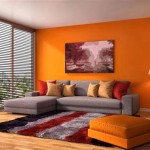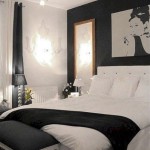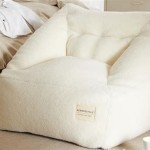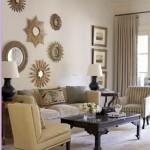How To Decorate Your Home Office for Productivity and Comfort
The shift towards remote work has underscored the importance of a well-designed home office. A dedicated workspace can significantly impact productivity, focus, and overall well-being. Decorating a home office effectively goes beyond aesthetics; it involves creating an environment that supports concentration, inspires creativity, and promotes comfort during long work hours. This article will explore key elements of home office decoration, focusing on optimizing space, incorporating ergonomic solutions, and establishing a visually appealing and functional workspace.
Optimizing Space and Layout
Effective space management is paramount in a home office, especially in smaller living areas. Consider the existing architecture and available square footage to determine the optimal layout. Prioritize functionality and accessibility when arranging furniture and equipment. A cluttered or poorly organized space can lead to distractions and hinder workflow.
Begin by assessing the available space. Identify the dimensions and any existing architectural features such as windows, doors, and built-in storage. These elements will influence the placement of desks, chairs, and other essential office components. If the space is limited, consider utilizing vertical storage solutions such as shelving units and wall-mounted organizers to maximize usable area.
The desk is the central element of any home office. Its placement should be strategic, considering natural light sources and minimizing glare on computer screens. Ideally, the desk should be positioned near a window to provide natural light and a view, which can reduce eye strain and improve mood. However, ensure that the sunlight does not directly shine on the screen, creating visibility issues. If direct sunlight is unavoidable, consider using blinds or curtains to control the light intensity.
Chair placement is also critical. The chair should be ergonomically designed to support proper posture and reduce the risk of musculoskeletal issues. Ensure there is adequate space to maneuver the chair comfortably, allowing for reaching various parts of the desk and accessing storage. Consider the proximity of the chair to other furniture, such as file cabinets, printers, and bookshelves.
Storage solutions should be integrated seamlessly into the overall design. Utilize shelving units, drawers, and cabinets to organize documents, stationery, and other office supplies. Labeling storage containers ensures that items are easily accessible. If space is limited, consider multi-functional furniture such as desks with built-in storage or ottomans that can serve as both seating and storage.
Cables and cords can contribute to clutter and disorganization. Invest in cable management solutions such as cable ties, conduits, and organizers to keep wires tidy and out of sight. This not only improves the aesthetics of the workspace but also reduces the risk of tripping hazards and damage to electrical equipment.
Finally, consider the flow of movement within the office. Ensure there is ample space to move freely between the desk, chair, and other essential areas. Avoid creating bottlenecks or obstacles that could impede workflow. A well-planned layout will contribute to a more efficient and comfortable work environment.
Ergonomic Considerations for Health and Productivity
Ergonomics plays a vital role in creating a healthy and productive home office environment. Investing in ergonomic furniture and accessories can significantly reduce the risk of musculoskeletal disorders such as carpal tunnel syndrome, back pain, and neck strain. Implementing ergonomic principles can also improve posture, reduce fatigue, and enhance overall well-being.
The chair is arguably the most important ergonomic element in a home office. An ergonomic chair should provide adequate lumbar support, adjustable height, and adjustable armrests. Lumbar support helps maintain the natural curvature of the spine, reducing pressure on the lower back. Adjustable height allows the user to position the chair so that their feet are flat on the floor and their knees are at a 90-degree angle. Adjustable armrests ensure that the arms are properly supported, reducing strain on the shoulders and neck. Invest in a high-quality ergonomic chair that meets individual needs and preferences.
The desk height should also be ergonomically appropriate. Ideally, the desk should be at a height that allows the user to maintain a neutral wrist position while typing. If the desk is too high, it can lead to wrist and shoulder pain. If the desk is too low, it can cause slouching and back pain. Consider investing in a height-adjustable desk, which allows the user to switch between sitting and standing positions throughout the day. Standing desks have been shown to improve energy levels, reduce fatigue, and promote overall health.
Monitor placement is another critical ergonomic consideration. The monitor should be positioned at arm's length and at eye level. This reduces strain on the neck and eyes. If using multiple monitors, position them so that the primary monitor is directly in front of the user and the secondary monitor is slightly to the side. Consider using a monitor arm to adjust the height and angle of the monitor for optimal viewing comfort.
Keyboard and mouse placement are also important. The keyboard should be positioned directly in front of the user, with the wrists straight and the elbows at a 90-degree angle. The mouse should be placed close to the keyboard to minimize reaching. Consider using an ergonomic keyboard and mouse that are designed to reduce strain on the wrists and hands. Wrist rests can also provide additional support and comfort.
Proper lighting is essential for reducing eye strain and improving visibility. Ensure that the home office is well-lit with a combination of natural and artificial light. Position task lighting strategically to illuminate the work area without creating glare. Avoid using overhead fluorescent lighting, which can cause eye strain and headaches. Instead, opt for adjustable desk lamps with warm, natural light.
Breaks are crucial for maintaining productivity and preventing fatigue. Take short breaks every hour to stretch, walk around, and rest the eyes. Use the 20-20-20 rule: every 20 minutes, look at something 20 feet away for 20 seconds. This can help reduce eye strain and improve focus. Incorporate ergonomic accessories such as footrests, back supports, and document holders to further enhance comfort and support.
Creating a Visually Appealing and Functional Workspace
A visually appealing home office can enhance mood, inspire creativity, and improve overall well-being. Incorporating personal touches, selecting appropriate colors, and adding decorative elements can transform a utilitarian workspace into a welcoming and inspiring environment. However, it’s essential to balance aesthetics with functionality to ensure the space remains conducive to productivity.
Color plays a significant role in influencing mood and productivity. Choose colors that are calming and conducive to concentration. Neutral colors such as beige, gray, and white can create a clean and uncluttered look. These colors can be complemented with accent colors that reflect personal style and preferences. Blue is often associated with calmness and focus, while green evokes nature and freshness. Avoid using overly bright or stimulating colors, such as red or orange, which can be distracting and overwhelming.
Personal touches can make the home office feel more inviting and comfortable. Incorporate elements that reflect personal interests and hobbies. Display artwork, photographs, or collectibles that inspire and motivate. Add plants to bring a touch of nature indoors and improve air quality. Personalizing the space can create a sense of ownership and connection, making it a more enjoyable place to work.
Organization is key to maintaining a visually appealing and functional workspace. A cluttered desk can be distracting and hinder productivity. Invest in storage solutions to keep documents, stationery, and other office supplies organized and out of sight. Use desk organizers, file cabinets, and shelving units to create a clutter-free environment. Regularly declutter the workspace to remove unnecessary items and maintain a sense of order.
Lighting can significantly impact the aesthetics and functionality of the home office. Maximize natural light by positioning the desk near a window. Supplement natural light with artificial lighting to ensure adequate illumination throughout the day. Use adjustable desk lamps to provide task lighting and reduce eye strain. Consider using warm, natural light bulbs to create a more inviting and comfortable atmosphere.
Sound management is also important for creating a productive workspace. Minimize noise distractions by using soundproofing materials such as acoustic panels, thick curtains, or noise-canceling headphones. Create a quiet and peaceful environment that is conducive to concentration and focus. Consider playing ambient music or nature sounds to help block out distractions and enhance relaxation.
Finally, consider the overall design aesthetic of the home office. Choose furniture and accessories that complement the existing décor of the home. Maintain a consistent style and theme throughout the space to create a cohesive and visually appealing environment. Whether the preference is for a modern, minimalist, or traditional style, ensuring that the design reflects personal taste and preferences is important.
:strip_icc()/home-office-decor-ideas-15-proem-studio-union-square-0527b42d3b864d82a9aa68dc7b982704.jpeg?strip=all)
How To Perfectly Decorate Your Home Office

Decorating Your Home Office For Ivity And Creativity

10 Tips To Decorate Your Home Office The Rustic Brush

15 Ways To Uniquely Decorate Your Office Desk Chairoffice

How To Decorate A Home Office Scott Mcgillivray

How To Decorate Your Home Office One Kings Lane Our Style Blog

How To Decorate Your Home Office With Style Best Fashion Design Graphic Interior Architecture Courses Training Institute Dreamzone Blog

How To Create A Budget Friendly Dream Home Office The Design Twins

Five Inspiring Ideas To Decorate Your Home Office Henpicked

How To Perfectly Decorate Your Home Office







